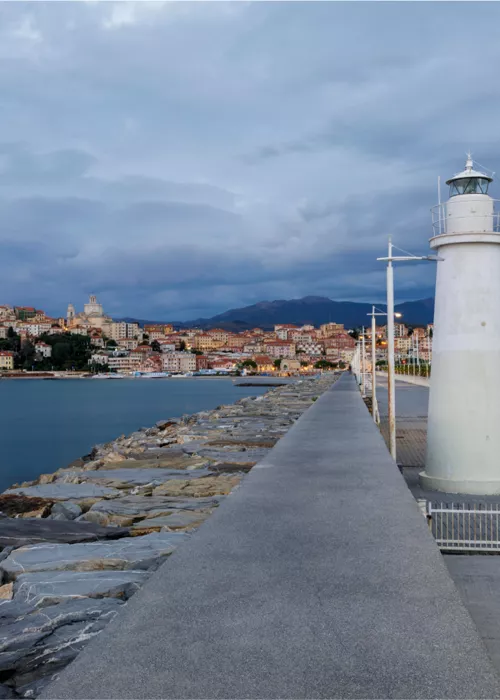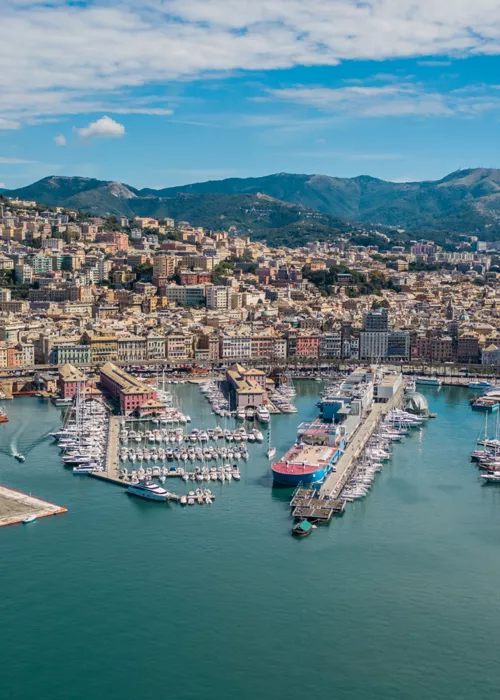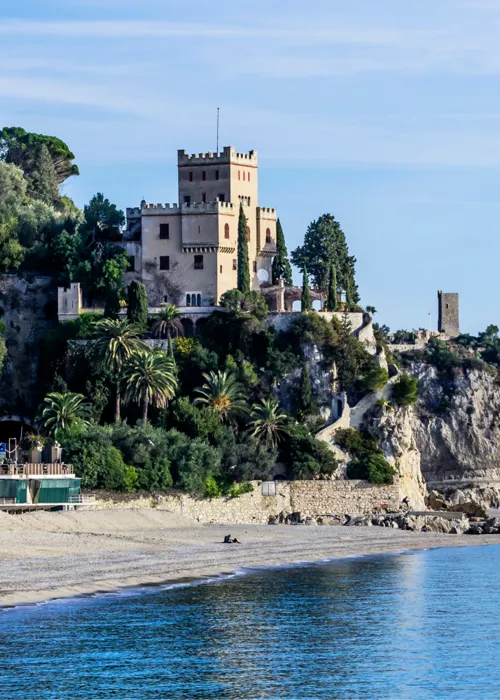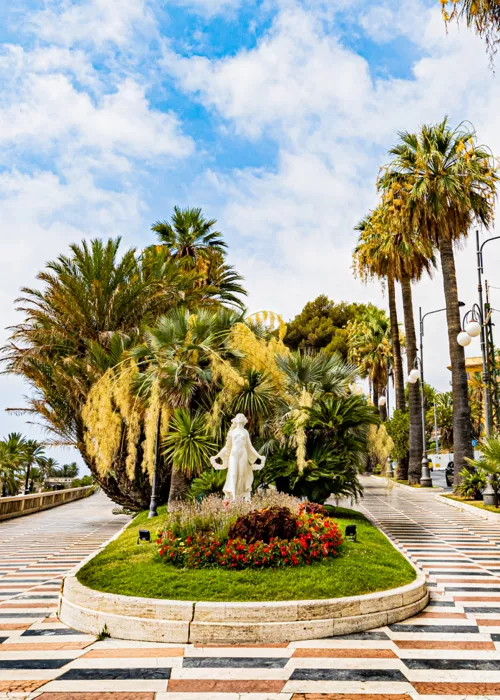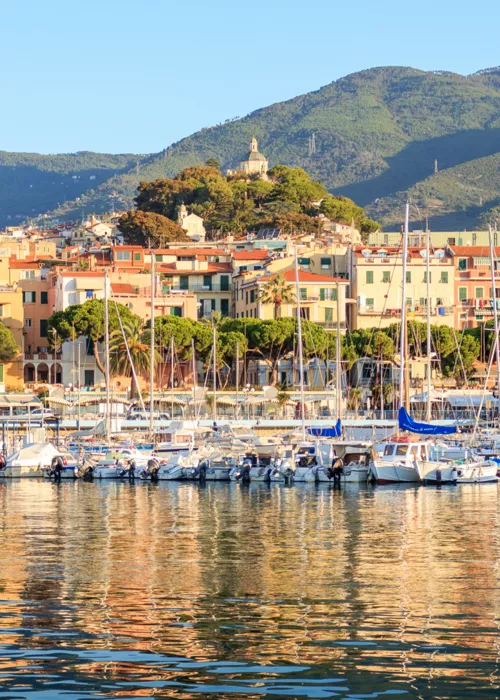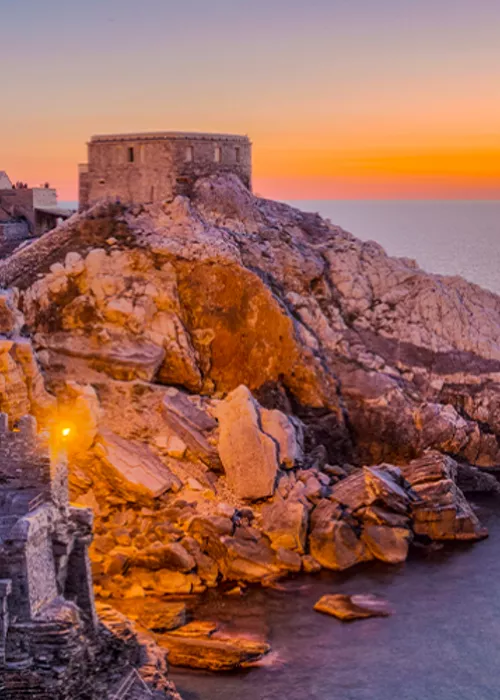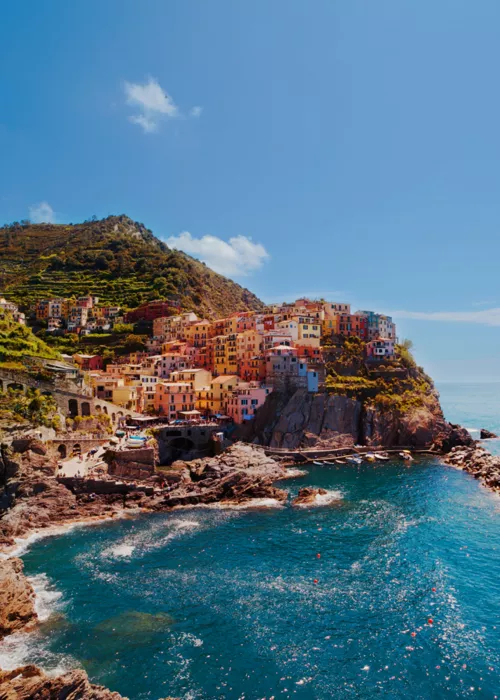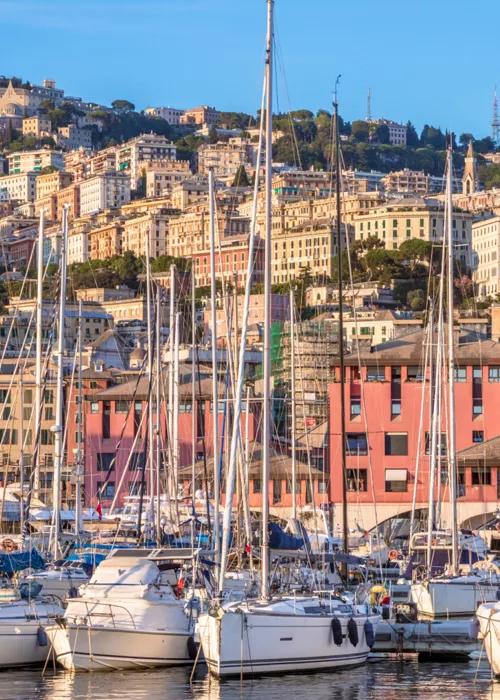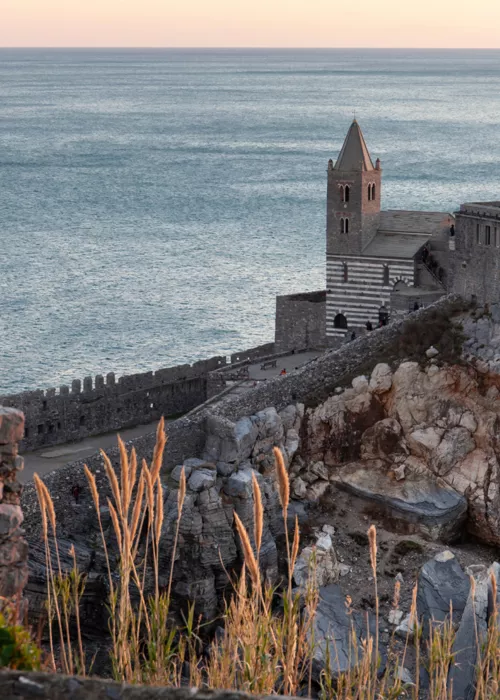Albenga

The city overlooks the Ligurian Sea about eighty kilometres from Genoa, practically in the middle of the Riviera di Ponente. It is a centre of primary tourist importance both for the beaches in front of the Isola Gallinara, and for the attractions of the historic centre such as the long Piazza S. Michele, the Piazza dei Leoni collection and the medieval houses on Via Bernardo Ricci. The Cathedral of San Michele and the extraordinary Baptistery stand out, surrounded by the Old Town Hall with the Ingauno Civic Museum and the Bishop's Palace with the Diocesan Museum. Continuing on the Via delle Medaglie d'Oro, beyond its historic buildings, you can reach the thirteenth-century Pontelungo in about ten minutes.
It is then
worth moving to the hamlet of Campochiesa to visit the Romanesque-Gothic church of San Giorgio, with a cycle of frescoes where the Last Judgement also depicts Dante, Virgil and other characters from the Divine Comedy. When it comes to gastronomy, Albenga does not disappoint either: witness the oil mill carved into the medieval walls that, in the Sommariva Museum, recounts the "Civilisation of the Olive Tree".
Church of St Pantaleon

From Albenga, provincial road 453 heads towards the Arroscia valley in the direction of Ranzo. However, a detour on provincial road 21 allows you to reach the Rainer Kriester Sculpture Park, where the contemporary German artist has left an environment suspended between art and nature in the greenery.
Ranzo, on the other hand, preserves less recent interventions in its vicinity, expressions of a surprisingly refined medieval religiosity. On a cliff overlooking the Arroscia stream is the small church of S. Pantaleo, which weaves together different periods and styles of construction: starting with the Proto-Romanesque for one of the apses, continuing into the 14th–15th century for the other apse and the entrance porch, and ending with the Baroque transformations. The doorways bear late 15th-century decorations by the "lapicidi di Cènova" (a school of artists named after another small town in the Arroscia valley), while the walls of the portico itself preserve extensive frescoes, also by local artists. Other wall paintings are located inside the building.
Pieve di Teco

The historic centre of Pieve di Teco has a timeless atmosphere, with high houses overlooking the Arroscia and the Roman bridge (built in the Middle Ages) that crosses the course of the waters downstream of the town.
Pieve di Teco is about fifteen kilometres upstream from Ranzo and about thirty kilometres from Albenga, along the Colle di Nava state road 28, and is surrounded by nature featuring hiking and mountain biking trails through the woods, on the edge of the areas protected by the Regional Natural Park of the Ligurian Alps.
Strolling through the village, one also encounters historical presences from recent centuries: the church of S. Giovanni Battista has a Romanesque bell tower but an 18th-century appearance, and the tiny Salvini Theatre dates from the 19th century. Finally, contemporary artworks can be visited in the small Museum of the Masks of Ubaga, located in the former 15th-century convent of the Augustinians.
Ormea

Continuing along state road 28 northwards, you enter Piedmont, in the Tanaro valley, nestled between the gentle slopes of the Langhe, the heights of the Monregalese and Liguria, with the Tanaro river running alongside the road. The railway that has stopped working and the cantonment houses are reminders of when the Ormea paper mill provided work for many. The town, seen from above, has the shape of a heart. But it is not only the heart shape that has made the many tourists who visit Ormea in summer fall in love with it. All around it is lush nature, composed of beech and chestnut forests and Alpine peaks on which to venture: Monte Antoroto, Pizzo d'Ormea, Monte Mongioie and the Marguareis massif.
The historic centre has retained its medieval layout and is crossed by an intricate maze of alleys (referred to as "trevi" in the Ormeasco dialect) overlooking houses of the 14th–15th century. The parish church of San Martino, dating from the end of the 15th century, has a Romanesque bell tower and, in the apse, 14th-century frescoes. Dominating everything are the imposing remains of the 10th-century castle, built in defence of the Saracen incursions, then fortified by the Savoy and reduced to ruin by the Napoleonic army.
Garessio

Another village on the banks of the Tanaro, Garessio, at the foot of the Colle San Bernardo, is a mountain village but close to the sea, and weaves Piedmontese rigour with Ligurian character. Its medieval core is called Borgo Maggiore: it dates back to 1100 and initially served as a stronghold, of which three of the four access doors remain, Porta Rose (the main one), Porta Jhape and Porta Liazoliorum, and part of the city walls. See the Geospeleological Museum and the Historical Archive, housed inside the Town Hall, the characteristic Piazza San Giovanni Battista, with its paving in black and white pebbles and the church of San Giovanni Battista with the octagonal baptistery that was part of an ancient chapel. The imposing parrocchiale di Maria Vergine Assunta ("parish church of the Assumption of the Virgin Mary"), which was originally a Dominican convent, is the result of the architect Francesco Gallo's design of 1717–28. The oldest church in Garessio is instead S. Maria Extra Moenia, a low building with a local stone bell tower in Roman-Gothic style dating back to 1448. Built in around the year 1000, it preserves the Gothic portal, some columns of the interior naves and a few traces of medieval painting from the ancient building. Then there is the Bricco, a group of houses clustered under the castle hill: among them is the 16th-century building with pinnacles incorporated into the wall, home to the Dominican tertiary nuns.
Castelvecchio di Rocca Barbena

At an altitude of 1142 metres, on a rocky outcrop stands Castelvecchio di Rocca Barbena, the oldest walled feudal village in the Neva Valley, with a medieval urban layout that is still intact. You can wander through winding alleys and streets, small squares, old wash houses, old ovens, stone arches and small shops selling typical products. Founded between the 12th and 13th centuries by the Marquises of Clavesana, who erected it in an elevated position to control the valley, it then passed to the Marquises of Carretto and in the 17th century it became part of the Republic of Genoa. The castle, which overlooks the village and offers a beautiful view of the valley, was built in the 11th century. The parish church of Santa Maria Assunta, rebuilt in the Baroque era on top of a previous building, has an older cusp bell tower. The village has been awarded an Orange Flag by the Touring Club Italiano. Before returning to Albenga, you can leave the car here and reach Zuccarello on foot, with an easy walk through olive and chestnut trees dedicated to Ilaria Del Carretto.
Zuccarello

Ilaria Del Carretto, daughter of Carlo, first marquis of the fief, was born here in Zuccarello. Ilaria married Paolo Giunigi, from Lucca, and moved there. She died prematurely in 1405 and Jacopo della Quercia commemorated her beautifully in the funeral monument preserved in the Cathedral of Lucca. Zuccarello is a delightful fortified village, where you can still feel the atmosphere that Ilaria must have experienced. The main street features low porticoes, arcades and pillars decorated with the trompe l'oeil so typical in Liguria. The two turreted gates to the north and south, Soprana and Sottana. Narrow alleys and a Roman bridge that is actually medieval, exactly like the Church of San Bartolomeo, squeezed between the buildings in the centre, with its original bell tower adorned with stone mullioned windows with two- and three-light mullioned windows, and traces of late 15th-century frescoes inside.



